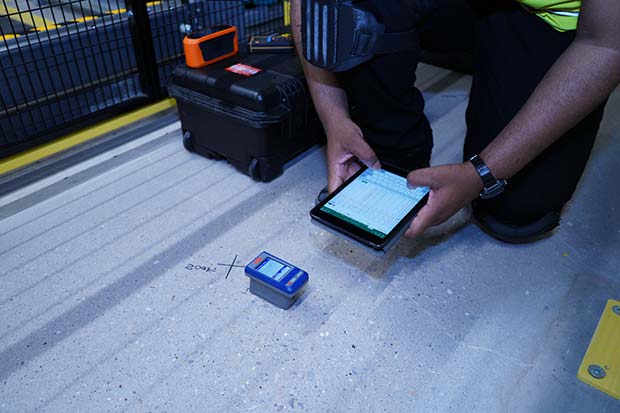The advent of order picking robots has put logistics centre floors in the spotlight as never before. Now a new service from RCR Industrial Flooring is addressing the emerging needs of owners and operators, by helping floors and MHE to work together in the most efficient way.
 Floor Dynamics is a new company within RCR’s Flooring Services division. Launched at IMHX, it harnesses RCR’s industrial flooring expertise and applies this to the precision-led, time-sensitive world of automated logistics. The result is a suite of services which offer insight into floor characteristics and how these may impact smooth, swift operations.
Floor Dynamics is a new company within RCR’s Flooring Services division. Launched at IMHX, it harnesses RCR’s industrial flooring expertise and applies this to the precision-led, time-sensitive world of automated logistics. The result is a suite of services which offer insight into floor characteristics and how these may impact smooth, swift operations.
The new company is headed by Andrew Keen, Chief Services Officer at RCR and part of its international senior management team.
“Warehouse floors are traditionally seen as a liability,” he notes. “However, we are proving that by analysing floors and working with them intelligently over time, they can be a source of competitive advantage in a world where every minute counts.”
The drive for flatness
Achieving perfect flatness has long been the holy grail of warehouse floor construction – and arguably with good reason. Small variances in the floor can magnify over the height of a reach truck, creating a dangerous lean or tilt.
However, the introduction of floor running robots has presented a new challenge. While VNA trucks operate in a single defined wheel path, robots generally run in defined paths but bi-directionally: they run north to south, as well as east to west. Correcting for a deviation in one direction can adversely affect vehicles crossing the path. Additionally, to gain more square metres of floor space, suspended floors or mezzanines are becoming more common, adding deflection under load into the equation.
“Some distribution centre operators are reporting issues with commissioning robots in their facilities” comments Andrew Keen. “The initial response has been the call to construct flatter floors. However, once the problem is clearly defined, the solution can be quite different. To achieve this, we need data that we can turn into meaningful information on which we can make decisions.”
Intelligence aids performance
For Floor Dynamics, understanding the floor’s unique ‘fingerprint’ is the first step. A complete picture is obtained by producing a high-definition map of the floor. No longer is it necessary to measure to a specific standard, as the surface profile can be assessed to any normative – even custom specifications. This, coupled with specialist tests for abrasion resistance, roughness, gloss, and coefficient of friction, etc., allows the assessment of the floor’s characteristics, which can also be repeated with certainty during its life.
But the potential is yet more exciting: by measuring the dynamic behaviour of vehicles in known positions on a defined surface, augmented and virtual reality models can be built. In turn, it is possible to create intelligent control systems to optimise performance.
Dilapidation management
During the life of a facility, not only do the characteristics of a floor change but new materials handling systems will be implemented. New tenants may even occupy the building. Floor Dynamics can survey the floor and determine what remediation, if any, is required for a change of use. BIM-ready models can also be created from the same dataset for O&M purposes.
“No part of a distribution centre works harder than the floor,” Andrew Keen concludes. “Some of the industry’s leading names are talking to us now because they are envisioning the future and realising it’s time to take floor optimisation seriously.”
It seems in the world of warehouse flooring, knowledge is indeed power.




Comments are closed.